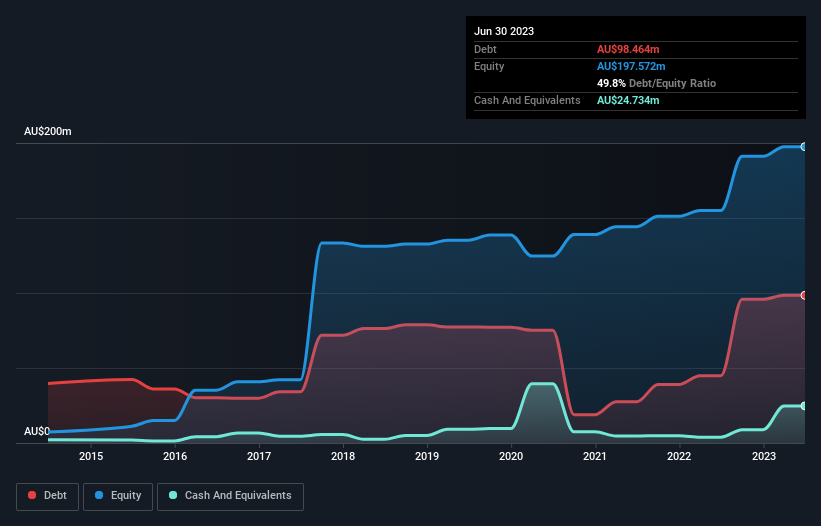
The external fund manager backed by Berkshire Hathaway's Charlie Munger, Li Lu, makes no bones about it when he says 'The biggest investment risk is not the volatility of prices, but whether you will suffer a permanent loss of capital.' When we think about how risky a company is, we always like to look at its use of debt, since debt overload can lead to ruin. We note that MotorCycle Holdings Limited (ASX:MTO) does have debt on its balance sheet. But should shareholders be worried about its use of debt?
Why Does Debt Bring Risk?
Debt is a tool to help businesses grow, but if a business is incapable of paying off its lenders, then it exists at their mercy. In the worst case scenario, a company can go bankrupt if it cannot pay its creditors. While that is not too common, we often do see indebted companies permanently diluting shareholders because lenders force them to raise capital at a distressed price. Of course, debt can be an important tool in businesses, particularly capital heavy businesses. When we think about a company's use of debt, we first look at cash and debt together.
See our latest analysis for MotorCycle Holdings
How Much Debt Does MotorCycle Holdings Carry?
You can click the graphic below for the historical numbers, but it shows that as of June 2023 MotorCycle Holdings had AU$98.5m of debt, an increase on AU$44.9m, over one year. However, it also had AU$24.7m in cash, and so its net debt is AU$73.7m.

How Strong Is MotorCycle Holdings' Balance Sheet?
According to the last reported balance sheet, MotorCycle Holdings had liabilities of AU$114.9m due within 12 months, and liabilities of AU$97.4m due beyond 12 months. On the other hand, it had cash of AU$24.7m and AU$12.1m worth of receivables due within a year. So it has liabilities totalling AU$175.5m more than its cash and near-term receivables, combined.
Given this deficit is actually higher than the company's market capitalization of AU$165.3m, we think shareholders really should watch MotorCycle Holdings's debt levels, like a parent watching their child ride a bike for the first time. Hypothetically, extremely heavy dilution would be required if the company were forced to pay down its liabilities by raising capital at the current share price.
In order to size up a company's debt relative to its earnings, we calculate its net debt divided by its earnings before interest, tax, depreciation, and amortization (EBITDA) and its earnings before interest and tax (EBIT) divided by its interest expense (its interest cover). Thus we consider debt relative to earnings both with and without depreciation and amortization expenses.
With a debt to EBITDA ratio of 1.7, MotorCycle Holdings uses debt artfully but responsibly. And the alluring interest cover (EBIT of 8.9 times interest expense) certainly does not do anything to dispel this impression. If MotorCycle Holdings can keep growing EBIT at last year's rate of 15% over the last year, then it will find its debt load easier to manage. When analysing debt levels, the balance sheet is the obvious place to start. But ultimately the future profitability of the business will decide if MotorCycle Holdings can strengthen its balance sheet over time. So if you want to see what the professionals think, you might find this free report on analyst profit forecasts to be interesting.
Finally, a business needs free cash flow to pay off debt; accounting profits just don't cut it. So we clearly need to look at whether that EBIT is leading to corresponding free cash flow. During the last three years, MotorCycle Holdings produced sturdy free cash flow equating to 73% of its EBIT, about what we'd expect. This free cash flow puts the company in a good position to pay down debt, when appropriate.
Our View
Both MotorCycle Holdings's ability to to convert EBIT to free cash flow and its interest cover gave us comfort that it can handle its debt. Having said that, its level of total liabilities somewhat sensitizes us to potential future risks to the balance sheet. Looking at all this data makes us feel a little cautious about MotorCycle Holdings's debt levels. While debt does have its upside in higher potential returns, we think shareholders should definitely consider how debt levels might make the stock more risky. The balance sheet is clearly the area to focus on when you are analysing debt. However, not all investment risk resides within the balance sheet - far from it. For instance, we've identified 1 warning sign for MotorCycle Holdings that you should be aware of.
Of course, if you're the type of investor who prefers buying stocks without the burden of debt, then don't hesitate to discover our exclusive list of net cash growth stocks, today.
New: Manage All Your Stock Portfolios in One Place
We've created the ultimate portfolio companion for stock investors, and it's free.
• Connect an unlimited number of Portfolios and see your total in one currency
• Be alerted to new Warning Signs or Risks via email or mobile
• Track the Fair Value of your stocks
Have feedback on this article? Concerned about the content? Get in touch with us directly. Alternatively, email editorial-team (at) simplywallst.com.
This article by Simply Wall St is general in nature. We provide commentary based on historical data and analyst forecasts only using an unbiased methodology and our articles are not intended to be financial advice. It does not constitute a recommendation to buy or sell any stock, and does not take account of your objectives, or your financial situation. We aim to bring you long-term focused analysis driven by fundamental data. Note that our analysis may not factor in the latest price-sensitive company announcements or qualitative material. Simply Wall St has no position in any stocks mentioned.
About ASX:MTO
MotorCycle Holdings
Owns and operates motorcycle dealerships in Australia.
Flawless balance sheet and good value.
Similar Companies
Market Insights
Community Narratives



